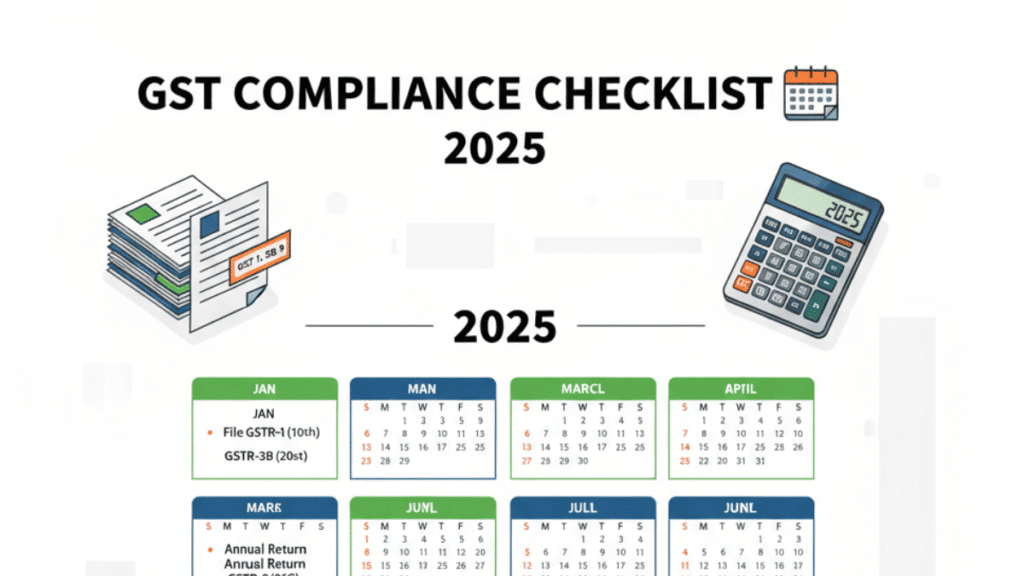Navigating GST compliance in 2025 requires meticulous planning and systematic execution. With the introduction of GST 2.0 reforms effective September 22, 2025, Indian businesses face new compliance challenges alongside enhanced opportunities. This comprehensive month-by-month GST compliance checklist ensures your business stays ahead of deadlines, avoids penalties, and maximizes benefits under the simplified tax structure.
Understanding GST 2.0: The New Compliance Landscape
The GST 2.0 framework has fundamentally transformed India’s indirect tax system. The streamlined structure now features three primary slabs: 5% for essentials, 18% for standard goods, and 40% for luxury items. This simplification impacts compliance requirements, return filing procedures, and audit thresholds across all business categories.
Key Changes Affecting Your Compliance Strategy
Simplified Tax Structure: The reduction from multiple slabs to three main categories requires businesses to reclassify their products and services. This reclassification affects pricing, invoicing systems, and input tax credit calculations.
Enhanced E-invoicing Requirements: From April 1, 2025, businesses with turnover exceeding ₹10 crores must upload invoices within 30 days to the Invoice Registration Portal. Non-compliance results in loss of input tax credit eligibility.
Revised Audit Thresholds: The GST audit limit has increased to ₹2 crores, providing relief to small and medium enterprises while maintaining compliance standards for larger businesses.
Month-by-Month GST Compliance Calendar 2025-26
April 2025: Financial Year Foundation
Critical Deadlines (April 2025):
- April 11: GSTR-1 filing for monthly filers (March transactions)
- April 13: GSTR-1 quarterly filing for QRMP taxpayers (January-March)
- April 20: GSTR-3B monthly return and tax payment
- April 22/24: GSTR-3B quarterly return for QRMP taxpayers
- April 30: GSTR-4 annual return for composition taxpayers
Essential Compliance Actions:
E-invoicing Threshold Assessment: Verify if your business crosses the new ₹10 crore threshold requiring mandatory e-invoicing from April 1, 2025. Update your invoicing systems to comply with 30-day reporting requirements.
QRMP Scheme Evaluation: Businesses with turnover ≤ ₹5 crores must decide on Quarterly Return Monthly Payment scheme participation by April 30. This decision impacts your filing frequency and cash flow management.
Annual Return Completion: File GSTR-4 for composition taxpayers covering FY 2024-25. Ensure all quarterly returns are reconciled and any discrepancies are resolved before the deadline.
Letter of Undertaking (LUT) Renewal: Export-oriented businesses must file Form RFD-11 for zero-rated supplies without IGST payment. The deadline is March 31 for the new financial year, but renewals can be processed in early April.
May 2025: System Optimization
Critical Deadlines (May 2025):
- May 10: GSTR-7 (TDS) and GSTR-8 (TCS) filing
- May 11: GSTR-1 monthly filing for April transactions
- May 13: GSTR-5 (Non-residents) and GSTR-6 (ISD) filing
- May 20: GSTR-3B monthly summary return
- May 25: PMT-06 payment for QRMP scheme taxpayers
Strategic Compliance Activities:
Input Tax Credit Reconciliation: Conduct thorough GSTR-2B reconciliation to identify mismatched invoices. Under GST 2.0, stricter ITC validation rules require immediate attention to invoice discrepancies.
HSN Code Updates: Review and update HSN classifications following GST 2.0 rate changes. Incorrect classifications can lead to wrong tax calculations and compliance issues.
E-Way Bill System Updates: Implement enhanced e-way bill generation procedures, especially for unregistered dealers using Form ENR-03. This new provision affects logistics and documentation requirements.
June 2025: Mid-Year Preparations
Critical Deadlines (June 2025):
- June 10: GSTR-7 and GSTR-8 filing
- June 11: GSTR-1 monthly filing
- June 15: First advance tax installment for income tax
- June 20: GSTR-3B and tax payment
Compliance Focus Areas:
Multi-Factor Authentication Implementation: Ensure all GST portal access complies with mandatory MFA requirements implemented from April 2025. This security measure affects all taxpayer logins and return filings.
Audit Preparation: Businesses exceeding ₹2 crore turnover should begin preparing for mandatory GST audits. Organize documentation including GSTR-9 and reconciliation statements.
Reverse Charge Mechanism Review: Update RCM compliance procedures following GST 2.0 changes. New regulations affect service recipients and import transactions.
July 2025: Quarterly Reconciliation
Critical Deadlines (July 2025):
- July 7: TDS return filing for Q1 (April-June)
- July 11: GSTR-1 monthly filing for June
- July 18: GSTR-1 quarterly filing for QRMP taxpayers (April-June)
- July 31: Income Tax Return filing for individuals
Strategic Activities:
Quarterly ITC Review: Conduct comprehensive Input Tax Credit analysis for Q1. Identify and rectify any credit reversals required under new compliance rules.
E-invoice Portal Optimization: Review e-invoice generation processes and ensure timely reporting within 30-day limits. Late reporting affects ITC eligibility and compliance ratings.
Vendor Verification: Implement enhanced vendor verification procedures to prevent fake invoice issues. GST 2.0 emphasizes genuine transaction verification.
August 2025: Compliance Strengthening
Critical Deadlines (August 2025):
- August 10: GSTR-7 and GSTR-8 filing for July
- August 11: GSTR-1 monthly filing
- August 20: GSTR-3B filing and payment
- August 25: GST challan payment and PMT-06 for QRMP
Focus Areas:
System Integration Testing: Ensure all updated GST software integrates properly with government portals. Test e-invoice generation, return filing, and payment systems.
Penalty Avoidance Measures: Review late fee structures and implement automated reminder systems. GST penalties have become stricter in 2025, with enhanced enforcement mechanisms.
Documentation Digitization: Complete digitization of GST records to support e-audit requirements. Modern compliance requires electronic record maintenance.
September 2025: Year-End Preparation Begins
Critical Deadlines (September 2025):
- September 10: GSTR-7 and GSTR-8 filing
- September 11: GSTR-1 filing for businesses with turnover > ₹1.5 crores
- September 20: GSTR-3B filing for all categories
Key Compliance Actions:
GST 2.0 Rate Verification: Conduct final verification of all rate applications following September 22 implementation. Ensure correct tax calculations across all product categories.
Annual Return Preparation: Begin GSTR-9 preparation for businesses exceeding ₹2 crore threshold. Early preparation prevents year-end compliance rush.
Refund Claim Management: Process pending refund claims before new restrictions take effect from October 1, 2025. Aadhaar authentication becomes mandatory for refund processing.
October 2025: Advanced Compliance
Critical Deadlines (October 2025):
- October 10: GSTR-7 and GSTR-8 filing
- October 11: GSTR-1 monthly filing
- October 18: GSTR-1 quarterly filing for July-September quarter
- October 20: GSTR-3B filing and tax payment
Strategic Focus:
Enhanced Compliance Measures: Implement Finance Act 2025 provisions effective October 1. These include stricter ITC timelines and enhanced penalty provisions.
Risk Assessment: Conduct comprehensive GST compliance risk assessment. Identify potential audit triggers and remediate issues proactively.
Technology Upgrade: Ensure systems support new compliance features including enhanced reconciliation and automated matching.
November 2025: Pre-Closure Activities
Critical Deadlines (November 2025):
- November 10: GSTR-7 and GSTR-8 filing
- November 11: GSTR-1 monthly filing
- November 20: GSTR-3B filing
- November 30: Rule 37A compliance deadline for ITC claims
Compliance Priorities:
Input Tax Credit Finalization: Ensure all ITC claims are supported by valid supplier filings in GSTR-3B. The November 30 deadline is critical for credit utilization.
Annual Reconciliation: Begin final reconciliation between books of accounts and GST returns. This preparation is essential for year-end audit requirements.
Composition Scheme Evaluation: Assess composition scheme eligibility for the upcoming financial year. Decision impacts FY 2026-27 compliance requirements.
December 2025: Year-End Compliance
Critical Deadlines (December 2025):
- December 10: GSTR-7 and GSTR-8 filing
- December 11: GSTR-1 monthly filing
- December 20: GSTR-3B filing
- December 31: GSTR-9 and GSTR-9C annual returns
Final Compliance Actions:
Annual Return Filing: Complete GSTR-9 for all eligible taxpayers and GSTR-9C for businesses exceeding ₹2 crore threshold. These returns require CA certification and detailed reconciliation.
Audit Completion: Finalize GST audits and address any observations. Ensure audit reports are submitted within prescribed timelines.
Next Year Planning: Develop compliance strategy for FY 2026-27 considering any regulatory changes announced during the year.
Interactive GST Compliance Calculator
Essential Calculator Features:
- Penalty Calculator: Compute late fees based on return type and delay period
- ITC Optimization Tool: Calculate maximum eligible input tax credit
- Turnover Threshold Checker: Determine applicable compliance requirements
- E-invoice Timeline Tracker: Monitor 30-day reporting compliance
- Audit Eligibility Assessor: Check if your business requires mandatory audit
Critical Compliance Thresholds 2025
| Compliance Requirement | Threshold Limit | Key Impact |
|---|---|---|
| GST Registration | ₹40 lakhs (₹20 lakhs for special states) | Mandatory registration and regular filing |
| E-invoicing | ₹10 crores (from April 2025) | 30-day reporting requirement |
| GST Audit | ₹2 crores | CA certification and GSTR-9C filing |
| Composition Scheme | ₹1.5 crores | Quarterly filing instead of monthly |
| E-way Bill | ₹50,000 per consignment | Mandatory for goods movement |
Penalty Structure and Avoidance Strategies
Common Penalty Categories
Late Filing Penalties: ₹50 per day for regular returns (₹25 CGST + ₹25 SGST) and ₹20 per day for NIL returns. Maximum penalty caps at ₹5,000 for small taxpayers.
Incorrect ITC Claims: Penalty up to 100% of tax amount incorrectly claimed. Enhanced verification makes this a high-risk area requiring careful documentation.
Non-registration Penalties: ₹10,000 or tax amount due, whichever is higher. Early registration prevents accumulation of penalties.
Penalty Avoidance Best Practices
Automated Compliance Systems: Implement software solutions with built-in deadline reminders and validation checks. Technology reduces human error and ensures timely compliance.
Regular Reconciliation: Conduct monthly GSTR-2B matching to identify and resolve discrepancies. Early detection prevents penalty accumulation.
Professional Advisory: Engage qualified GST practitioners for complex compliance issues. Expert guidance prevents costly mistakes and ensures optimal compliance.
Regional Considerations and Cultural Context
State-Specific Variations
Special Category States: Northeastern states may have different registration thresholds and compliance timelines. Businesses operating across states must track multiple requirements.
Festival Season Planning: Plan compliance activities around major festivals like Diwali, Durga Puja, and regional celebrations. Extended holidays can affect filing deadlines and payment processing.
Monsoon Impact: Prepare backup systems for monsoon season disruptions in July-September. Power outages and connectivity issues can affect online filing capabilities.
Joint Family Business Considerations
Multiple Proprietorship: Joint family businesses often involve multiple GSTINs requiring coordinated compliance. Centralized monitoring prevents missed deadlines.
Succession Planning: Address GST compliance transfer procedures for family business transitions. Proper documentation prevents compliance gaps during ownership changes.
Agricultural Integration: Rural businesses must coordinate GST compliance with agricultural income cycles and seasonal cash flows.
Learn More about GST on Official Government of India Website here
Technology Integration for Streamlined Compliance
Essential Software Features
Real-time Data Sync: Ensure your GST software provides real-time synchronization with government portals. This prevents data mismatches and filing errors.
Automated Reconciliation: Implement tools that automatically match invoices between GSTR-1, GSTR-2B, and books of accounts. Manual reconciliation becomes impractical with GST 2.0 volumes.
Multi-location Management: For businesses with multiple locations, centralized compliance management prevents oversight and ensures uniform standards.
Backup and Disaster Recovery
Cloud Storage: Maintain GST records in secure cloud storage with regular backups. Compliance requires 6-year record retention under GST law.
Offline Capabilities: Ensure critical compliance functions work offline during internet disruptions. Many businesses miss deadlines due to connectivity issues.
Data Security: Implement robust cybersecurity measures protecting sensitive GST data. MFA requirements emphasize security importance.
Advanced Compliance Strategies
Proactive Audit Management
Internal Audit Schedule: Conduct quarterly internal GST audits to identify compliance gaps before official audits. This proactive approach prevents penalty situations.
Documentation Standards: Maintain audit-ready documentation with proper indexing and digital organization. Quick document retrieval impresses auditors and reduces assessment time.
Vendor Compliance Monitoring: Regularly verify vendor GST compliance to prevent ITC loss. Non-compliant vendors can jeopardize your credit claims.
How to Register Banking Complaints Online with RBI’s Banking Ombudsman
Cash Flow Optimization
ITC Planning: Strategically time purchases to optimize input tax credit utilization. Proper planning improves working capital management.
Payment Scheduling: Align GST payment dates with business cash flow cycles. Early payment prevents interest charges while late payment optimization manages cash flow.
Refund Management: Efficiently process GST refunds following new Aadhaar authentication requirements. Delays in authentication can block refund processing.
Call-to-Action Elements
Strategic CTA Placements:
“Download Monthly Checklist” – Customizable compliance calendar after threshold analysis section
“Calculate Your Penalties” – Interactive penalty calculator following penalty structure discussion
“Schedule Compliance Review” – Professional consultation booking after advanced strategies section
“Access Automated Tools” – Software integration solutions following technology discussion
Frequently Asked Questions (FAQs)
1. What is the new GST audit threshold for FY 2025-26?
The GST audit threshold has been increased to ₹2 crores for FY 2025-26. Businesses exceeding this annual turnover must get their accounts audited by a Chartered Accountant and file GSTR-9C along with GSTR-9. This increase provides relief to smaller businesses while maintaining compliance oversight for larger enterprises.
2. When does the new e-invoicing time limit of 30 days take effect?
The 30-day e-invoicing reporting requirement becomes effective from April 1, 2025, for businesses with turnover exceeding ₹10 crores. This means eligible businesses must upload their invoices to the Invoice Registration Portal within 30 days of invoice generation, failing which they may lose input tax credit eligibility.
3. What are the penalties for late GST return filing in 2025?
Late filing penalties are ₹50 per day for regular returns (₹25 CGST + ₹25 SGST) and ₹20 per day for NIL returns. The maximum penalty is capped at ₹5,000 for businesses with NIL liability, but can accumulate significantly for regular filers with extended delays.
4. How do GST 2.0 rate changes affect existing contracts?
GST 2.0 rate changes require businesses to review existing contracts and pricing structures. Products moved from 12% to 5% or 18% slabs need immediate rate adjustments in invoicing systems. Businesses should communicate changes to customers and update contract terms to reflect new tax implications.
5. What documents are required for GST audit under the new ₹2 crore threshold?
Required documents include GSTR-9 annual return, GSTR-9C reconciliation statement, audited financial statements, purchase and sales registers, input tax credit documentation, and e-way bill records. The audit must be conducted by a qualified Chartered Accountant with proper certification.
6. Can small businesses with turnover below ₹2 crores avoid GST audit?
Yes, businesses with annual turnover below ₹2 crores are exempt from mandatory GST audit requirements. However, they must still maintain proper books of accounts and may be subject to departmental audits if discrepancies are detected in their filings.
7. How does the new QRMP scheme selection work for FY 2025-26?
Businesses with turnover up to ₹5 crores can opt for the Quarterly Return Monthly Payment (QRMP) scheme. Under this scheme, taxpayers file quarterly returns but make monthly payments using Form PMT-06. The scheme selection must be made before the start of the financial year and affects the entire year’s compliance pattern.
Conclusion
The Ultimate GST Compliance Checklist 2025 provides your business with a comprehensive roadmap for navigating the new GST 2.0 landscape. With simplified tax slabs, enhanced e-invoicing requirements, and revised audit thresholds, staying compliant requires systematic planning and execution.
Key Success Factors: Embrace technology integration, maintain proactive documentation standards, and implement automated reconciliation processes. The increased audit threshold to ₹2 crores provides relief to smaller businesses, while enhanced compliance measures ensure system integrity.
Strategic Implementation: Use this month-by-month guide as your compliance framework, adapting deadlines and requirements to your specific business needs. Regular monitoring of regulatory updates and professional advisory support will ensure continued compliance success.
Future-Ready Approach: GST compliance in 2025 demands digital-first thinking, automated processes, and strategic planning. Businesses that invest in robust compliance systems today will benefit from reduced penalties, optimized cash flow, and enhanced regulatory relationships.
Stay ahead of compliance requirements, leverage technology effectively, and transform GST obligations from burden to competitive advantage. Your business success depends on maintaining excellence in tax compliance while focusing on growth and innovation.
Ready to optimize your GST compliance strategy? Download our customizable monthly checklist and ensure your business stays ahead of all GST 2.0 requirements throughout FY 2025-26.



